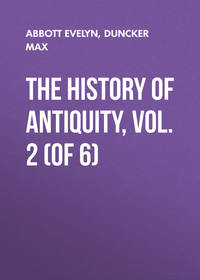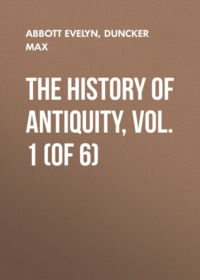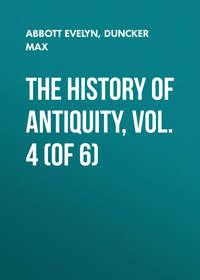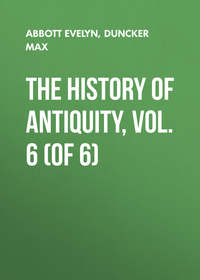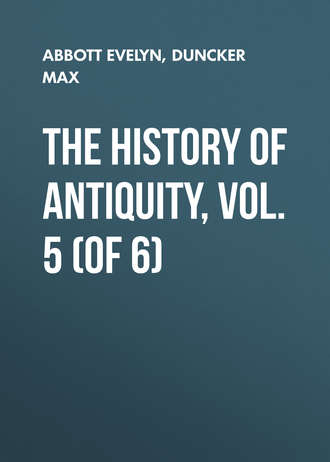 полная версия
полная версияThe History of Antiquity, Vol. 5 (of 6)
315
"Vend." 9, 172-180, 187-196.
316
"Vend." 13, 126-129.
317
"Vend." 18, 1-17.
318
"Vispered," 3, 13, 14. Above, p. 165.
319
The Mobedh of Middle Persian is magupat, i. e. lord of the Magians (p. 60). The derivation of the name Magus from the Turanian imga (apparently = honourable) can only be adopted by those who regard the Magians as descendants of the Turanians, or at any rate as containing a strong admixture of Turanians; a view which rests on the theory that the second series in the inscriptions of the Achæmenids is the Median translation of the Persian inscriptions. With this view I cannot agree; all that we learn from the Greeks of the customs, manners, and names of the Medes bears the mark of an Arian origin, and is in harmony with what is attributed to the Persians. In the inscription of the second class at Behistun, Gaumata is not called imga but magush.
320
"Cyri instit." 8, 1, 23.
321
Herod. 3, 79.
322
Herod. 3, 73.
323
Strabo, p. 727; Pausanias, 5, 27, 3.
324
Ammian. 23, 6, 32-35; Agathias, 2, 26.
325
Philostratus in Rapp, "Z. D. M. G." 20, 71.
326
Herod. 1, 120.
327
"Cyri instit." 7, 5, 20; 8, 1, 8.
328
Arrian, "Anab." 6, 29.
329
Herod. 7, 191.
330
Curtius, 3, 7; Ammian. 23, 6, 34.
331
"Alcibiad. I." p. 122.
332
Nic. Dam. fragm. 67, ed. Müller.
333
Plut. "Artaxerxes," c. 3.
334
Diog. Laert. prooem. 6.
335
Fragm. 66, ed. Müller; cf. infra Bk. 8, c. 4.
336
Herod. 1, 128; Ctes. "Pers." 15. The excerpt says 4 °Chaldæans, but obviously Magi are here meant.
337
Prooem. 7. Above, p. 190. The further statements of Diogenes about the white robes of the Magians, their avoidance of all ornament and gold, of their lying on the ground, and staff of reed, deserve little notice, inasmuch as the source whence they are derived is unknown.
338
"Cyri instit." 8, 7, 3.
339
"Cyri instit." 8, 7, 3; 7, 5, 20; 8, 1, 8; Curtius, 3, 3, 8.
340
Strabo, p. 733.
341
Pausan. 5, 27, 5, 6.
342
"Mihr Yasht," 38, 116, 117.
343
"Vend." 1, 18, 20; 18, 22-32.
344
Herod. 1, 136; Plato, "Alcib. I." p. 122; Xen. "Cyri instit." 8, 8, 2; Diod. 16, 43.
345
"Vend." 18, 35-42; 53-57.
346
"Vend." 3, 105 ff.
347
Loc. cit. 3, 1-20.
348
Herod. 7, 31.
349
"Œconom." 4, 13 ff.
350
Ibid. 4, 20-24.
351
Ibid. 4, 8-12; "Cyri instit." 8, 6, 16.
352
Darmesteter, "Haurvatat et Ameretat," p. 64 ff.
353
"Vend." 13, 125-162.
354
"Vend." 15, 2, 3, 4.
355
"Vend." 15, 5, 20, 21, according to Goldner's translation. [Cf. Darmesteter.]
356
"Vend." 13, 97-105.
357
"Vend." 13, 26-47.
358
It is not certain whether the udra of the Vendidad is the water-dog (spaniel?) or the otter.
359
"Vend." 13, 169-174; 14, 4-75.
360
Agath. 2, 24.
361
"Vend." Farg. 17.
362
"Wer den Urin mit vorgestrecktem Fusse lässt macht die Drudsch schwanger," so dass sie neue Unholde gebären.
363
"Vend." 5, 45-55, 136-157; 7, 158-182.
364
Herod. 1, 133; Xen. "Cyri instit." 1, 2, 16; 8, 9, 11; Plin. "H. N." 28, 19.
365
"Vend." 9, 161.
366
"Vend." 9, 187.
367
"Vend." 5, 23-25.
368
"Vend." 3, 140-147; 8, 87.
369
"Vend." 10, 11, 12, 17, 18, 26-28.
370
"Vend." 8, 275, 276.
371
"Vend." 9, 119-158; 19, 69-80.
372
"Vend." 5, 83-108; 7, 4 ff.
373
"Vend." 9, 168-171; Farg. 10.
374
"Vend." 5, 124-135.
375
"Vend." 12, 1-59.
376
"Vend." 4, 130-133.
377
"Vend." 14, 64-66.
378
"Vend." 18, 123-133, after Harlez' translation. [Cf. Darmesteter.]
379
"Vend." 15, 126.
380
"Vend." 15, 125.
381
"Vend." 18, 115.
382
"Vend." 18, 23.
383
Herod. 1, 135, 136.
384
Plato, "Aloib. I."; p. 121.
385
Herod. 1, 137.
386
"Ethic. Nicom." 8, 10, ed. Zell.
387
Curt. 5, 9; Plut. "Artax." c. 5.
388
Ammian, 23, 6.
389
Herod. 3, 70, 88; Dinon. fragm. 17, ed. Müller; Ctes. "Pers. Ecl." 44.
390
Plut. "Themist." c. 26.
391
Herod. 3, 31; Diogen. Laert. Prooem. 6; Plut. "Artax." c. 26; Ctes. "Pers. Ecl." 44; Agathias, 2, 23; Heracl. Cum. fragm. 7 ed. Müller.
392
The regulations respecting sexual intercourse, abortion, etc., which here follow in the German text will be found in "Vend." 16, 33-40; 18, 100-122, 136, 152; ib. 15, 9-17, 60; 18, 115; ib. 18, 115-119; ib. 8, 74-82; ib. 8, 96-106.
393
"Rigveda," 10, 97, 17; "Atharvaveda," 2, 10, 2; 8, 1, 18 in Darmesteter loc. cit. 73, 76.
394
"Vend." 20, 19, 25.
395
"Vend." 22, 7-38.
396
"Vend." 21, 3-19.
397
Justi, "Bundehesh," c. 24.
398
West, "Mainyo-i-Khard," c. 62. Above, p. 172.
399
"Vend." 20, 11-20.
400
"Vend." 7, 118, 121.
401
"Vend." 7, 105, 117.
402
"H. N." 30, 1.
403
Von Gutschmid ("Das iranische Wandeljahr, Berichte der K. Sächsischen Gesellschaft der Wiss." 1862) places the establishment of the cycle, by which, in order to bring the year of 365 days into agreement with the natural time, a month was inserted every 120 years, and consequently the introduction of the East Iranian calendar into the whole kingdom, in the year 411, or between 428 and 381 B.C. That the beginning of the year was universally placed in the spring after the introduction of this calendar, and fixed between March and the middle of June, would follow from the importance of the Farvardin festival, even if it were not sufficiently vouched for by other evidence. The Bundehesh (c. 25) speaks of the year as fixed, inasmuch as it reckons the shortening of the days from a certain day in the month of Tir, and puts the shortest day on the 20th of the month of Din, yet it adds that the priests reckoned on this basis, and that the lunar year did not correspond to the year thus calculated. The Cappadocian names for the months are those of the East Iranian calendar; and the Cappadocians cannot have obtained these till the calendar was current throughout the whole kingdom of the Achæmenids. On this ground also Von Gutschmid's dates do not seem to be too high.
404
"Vend." 1, 48; 6, 6 and loc. cit.
405
"Vend." 7, 65-71.
406
"Vend." 3, 122-136.
407
"Vend." 6, 93-95; 8, 13; 3, 50-54.
408
"Vend." 5, 13, 14, 47, 48.
409
"Vend." 6, 98 ff.
410
"Vend." 6, 106.
411
"Vend." 7, 126-147.
412
"Vend." 8, 34-36; 130-228.
413
"Vend." 8, 38-64.
414
"Vend." 8, 271-310; 9, 164-166.
415
"Vend." 5, 15-21, according to Geldner's rendering.
416
"Vend." 5, 1-22; 7, 189-191.
417
Herod. 1, 140; 3, 16.
418
Strabo, p. 517.
419
Strabo, p. 735. Cf. p. 520.
420
"Quaest. Tuscul." 1, 45.
421
Euseb. "Praep. Evang." p. 277.
422
Agath. 2, 23.
423
Diod. 17, 71; Arrian, "Anab." 3, 22; 6, 29.
424
Ctes. "Pers. Ecl." 44, 46; Strabo, p. 730.
425
Arrian, l. c.; Justin, 11, 15; Aelian, "Var. Hist." 6, 8; Plut. "Alex." c. 30.
426
Diod. 17, 71; cf. Ctes. "Pers. Ecl." 15.
427
"Vend." 1, 46, 48, 60, 64; cf. above, p. 137, 138.
428
"Yaçna," 26.
429
Above, p. 52. The Mainyo-i-Khard contains some rules on the duties of the king. The prince is to defend the city and land against enemies and risings, to respect water and fire, to keep at a distance bad laws and customs, and promote the worship of Auramazda, and good works, and to bring back to the right way those who have left it. A king of this kind is like the Yazatas and Amesha Çpentas: c. 15, 20, 33, 68, ed. West.
430
"Vend." 14, 32-40.
431
Arrian, "Anab." 4, 1, 5.
432
"Vend." 13, 143-145.
433
"Vend." 4, 4-53 according to Harlez.
434
"Vend." 4, 54-113. Even after all that has been advanced by De Harlez, "Avesta," p. 101, I cannot convince myself that the stripes appointed here and elsewhere in the Vendidad are to fall, not on the guilty, but on animals of Angromainyu. If animals are to be killed, we are told so expressly in the Vendidad, and this duty is often mentioned along with the stripes (p. 209). To kill twice 90 or 200 flies or lizards is no equivalent for murdering a man. I allow that no one could endure blows by thousands, if they were given in earnest, yet in running a "muck" five and six hundred very severe blows have been endured. In my opinion the punishments of the Avesta are not intended for legal penalties; they mark what was needed, in the opinion of the priests, to expel the evil disposition, which could recur again and again.
435
"Vend." 4, 120; "Astad Yasht," 1; Justi, "Handbuch," sub. voc.
436
Flügel, "Mani," s. 407; Mohl, "Livre des Rois," Intro. Mordtmann, "Z. D. M. G." 19, 485 ff; Nöldeke, "Tabari," s. xv.
437
Nohodares in Ammian, 1, 14, 3; 1, 25, 3.
438
Spiegel, "Eran," 1, 557.
439
"Zamyad Yasht," 56 ff. Above, p. 37.
440
Ritter, "Erdkunde," 8, 153, 183, 491, 561.
441
Chanikof, in Spiegel, "Eran," 1, 556.
442
"Farvardin Yasht," 147.
443
"Vend." 1, 42; Behist. 2, 92.
444
Plin. "H. N." 6, 18, (48).
445
Alexander came from Hyrcania and Parthia to the land of the Tapurians. According to Arrian's statements, the Hyrcanians, Parthians and Tapurians were all under one leader in the army of Darius III. "Anab." 3, 8, 4; 3, 11, 4; Strabo, p. 507, 508, 514, 524; Justin, 12, 3; 41, 5.
446
Herod. 1, 110.
447
Polyb. 5, 44; 10, 27. Cf. Curt. 3, 2 ff.
448
Strabo, p. 523-525.
449
In the most recent times it has been maintained that the Medes were of Turkish-Tatar (Altaic) family, but this view rests simply on the assumption that the inscriptions of the second class in the inscriptions of the Achæmenids must have been written in the language of the Medes. This hypothesis contradicts everything that has come down to us of Median names and works, and the close relationship between the Medes and Persians. Whether the Arians, on immigrating into Media, found there Turkish-Tatar tribes, overpowered, expelled or subjugated them, is another question. If this were the case, the fragments of the population could hardly have exercised any influence worth mentioning on the Arian Medes.
450
Paraetacene is derived no doubt from parvata, mountain, or parvataka, mountainous. Strabo remarks that when the Persians had conquered the Medes, they took some land from them. The distance between Persepolis and Ecbatana was twenty marches; Alexander reached the borders of Media on the twelfth day after leaving Persepolis. Arrian, "Anab." 3, 19.
451
Strabo, p. 73; 509.
452
Under the Sassanids Media (Mah) consisted of four regions: Aderbeijan, Rai (Rhagiana), Hamadan (Ecbatana), Isfahan.
453
Herodotus allows the Matieni a considerable extent, for he includes under the name the Armenians and the inhabitants of Atropatene. Later authors confine the Matieni to the region round the lake of Urumiah; in this sense, Polybius, quoted above in the text, limits Media in the North by the Cadusians and Matieni.
454
Herod. 3, 106; 7, 40.
455
Strabo, p. 525; Diod. 17, 110; Arrian, "Anab." 7, 13.
456
Behist. 1, 13. Strabo's Νησαία (p. 509, 511), the Nisiaea of Pliny (6, 29), the Parthaunisa of Isidore of Charax, must be sought in the neighbourhood of Nishapur, which was built by Shapur II. The Avesta puts Niça between Merv and Balkh.
457
Diod. 19, 44. Alexander in eleven forced marches advanced from Ecbatana to Ragha.
458
Isid. Ch. "M. P." c. 5.
459
Mordtmann, "B. d. Bair. Akademie," 1876, s. 364.
460
Diod. 2, 13; 17, 110. The city of Baptana, which Isidore (c. 5) mentions "as situated on a mountain in Cambadene," is in any case Bagistana (Behistun).
461
Herodotus, 1, 95-101.
462
Herod. 1, 102.
463
Vol. III. 257 ff. According to the reigns which Herodotus allows to Deioces and his successors, 150 years before the overthrow of Astyages, which took place 558 B.C., i. e. 708, but, according to the total given by Herodotus – 156 years, 714 B.C.
464
Volney, "Recherches," 1, 144 ff.
465
In order to remove this objection, the dates of Deioces and Phraortes must be transposed, and the 22 years of Phraortes given to the former, the 53 years of Deioces to the latter. Phraortes would then have marched out against the Assyrians in extreme old age, and fallen in the battle.
466
Herod. 1, 96.
467
Vol. III. Bk. 4; Chaps. 1, 4, 5-8.
468
According to Von Gutschmid. Cf. supr. p. 278.
469
Vol. II. p. 319. I cannot accept the theory which Lenormant has attempted to establish on the geographical differences in the inscriptions of Shalmanesar II. and Tiglath Pilesar II. – that the Medes and Persians obtained possession of Western Iran shortly before the middle of the eighth century. "Lettres Assyriolog." and "Z. Aegypt. Spr." 1870, s. 48 ff.
470
Vol. III. 3-5.
471
Vol. III. 85.
472
Vol. III. 101.
473
Vol. III. 113.
474
Vol. III. 150.
475
Vol. III. 167.
476
That is the reason why I cannot regard the parallels which Von Gutshchmid suggests ("Neue Beiträge," s. 90 ff.) of the struggle between the Arsacids and Seleucids, and the relations between the Great Mogul and the Mahrattas, as pertinent.
477
The Patusarra of Esarhaddon might be the Patisuvari of Darius; the Pateischoreans, whom Strabo quotes among the tribes of the Persians; Von Gutschmid, loc. cit. s. 93, but in the Babylonian version of the inscription of Behistun the Pateischoreans are called Pidishuris.
478
Von Gutschmid, loc. cit. s. 88; below, c. 3.
479
Vol. III. 280. The Assyrian inscriptions are silent from 644 B.C. downwards. Von Gutschmid, "Neue Beitr." s. 89. From this silence I have concluded, and still conclude, that the liberation of the Medes took place towards 640 B.C., and moreover that the victory of the Assyrians over Phraortes, and his death in battle did not bring about a decisive change in favour of the Assyrians.
480
Herod. 1, 72. In Xenophon, who represents Astyages as reigning before Cyaxares, Astyages had subjugated the king of Armenia; the rebellion of this king was afterwards repressed by Cyaxares. "Cyri instit." 3, 1, 6 ff.
481
Vol. III. 287, 438. Even after the discussions of Gelzer ("Rheinisches Museum," 1875, s. 264 ff.) on the date of the eclipse, I believe that Oltmann and Bailly's calculation may hold good for it, until it is proved astronomically that in the year 610 B.C. an eclipse of the sun would not have been visible in Asia Minor. If this were proved, Herodotus' dates for Cyaxares, who not only in his work but on the evidence of the inscription of Behistun, was the founder of the Median empire, would have to be thrown back more than half a century, which the date of Cyrus does not allow. To assume a confusion of Cyaxares with Astyages in Herodotus, is impossible, for Cyaxares is twice expressly mentioned (1, 74, and 103), and moreover Astyages is spoken of as the son of Cyaxares to whom Aryanis was married. Nor can I regard it as finally proved that the double capture of Sardis rests simply on Callisthenes, and a deduction from Strabo. Gelzer agrees that the incursions of the Cimmerians into Asia Minor and their establishment in Cappadocia must be placed at the least before the year 705 B.C. ("Z. Aegypt. Sprache," 1875, s. 18); the devastation of Phrygia by the Cimmerians he puts in the year 696 or 676 B.C. According to the dates of Eusebius Midas (the husband of Damodike) began to reign in Olymp. 10, 3 = 738, and took his own life in Ol. 21, 2 = 695 (Euseb. ed. Schöne, 2, 82, 85); his reign extended therefore from 738 to 695 B.C. Hence the devastation of Phrygia by the Cimmerians must have taken place in the year 695. If they were masters of Phrygia at this date, it is not easy to see why these successes did not carry them on into Lydia. As a fact, this is far from improbable; and if the image at Nymsi is their work, they would not have had any time for it in 630 B.C., for that incursion was merely a "plundering raid," and the change in the dynasty of Lydia, the accession of Gyges in the year 689 B.C. (Vol. III. 416), seems to me to point to some previous violent change. Besides, Strabo's words, p. 61, and p. 647, are plain and conclusive enough, so that I see no reason to attach much weight to the interpretation of the passage, p. 627. Cf. Cæsar, "Ind. lect. Marb. Sem. aestivum," 1876.
482
Vol. III. 284 ff., 291.
483
Diod. 2, 34; Nicol. Damasc. fragm. 66.
484
Nicol. Damasc. fragm. 9, 10, ed. Müller; Diod. 2, 33; Ctes. Fragm. 52, ed. Müller.
485
Roxane and Roxanace are both formed from the old Bactrian raokshna. Müllenhoff, "Monatsberichte Berl. Akadem." 1866, s. 562.
486
Ctes. Fragm. 25-28, ed. Müller; Nic. Damasc. fragm. 12 ed. Müller.
487
Oppert gives the form of the second version as Çakuka Iskunka.
488
Choerilus in Strabo, p. 303; Herod. 3, 93; 7, 64; 9, 71; Ptolem. 6, 13; Curtius, 7, 4, 6; Arrian, "Anab." 3, 13; Cf. Plut. "Crassus," 24.
489
Nicol. Damasc. fragm. 66, ed. Müller.
490
"Ind." 1, 1.
491
Diod. 2, 13; 17, 110; Strabo, p. 127.
492
Diod. 2, 13.
493
Herod. 1, 98, 99.
494
Polyb. 10, 27.
495
17, 110.
496
"Mans. Parth." c. 6.
497
Judith, i. 2-4. On the date of the composition of this book, cf. Volkmar. "Rheinisches Museum," 12, 481. In any case it dates from the end of the first or the second century of our reckoning.
498
Thuc. 2, 13, and the Scholia.
499
Diod. 2, 8.
500
Diod. 17, 71.
501
Hence I see no reason for connecting the colours of the turrets with the Babylonian star-worship. The only fact in favour of this is the black of the second wall; but as the highest turrets exhibited the two most precious metals, the others may have received the colours of the remaining five, over all of which Kshathra vairya presided, and in the order of the Avesta in which silver and copper follow gold, while iron and steel end the list. It can hardly be proved that Babylonian star-worship had a decisive influence among the Medes at the time of Cyaxares. Isaiah xiii. 17 might be quoted against the wealth of Ecbatana, but this passage only gives the idea of the writer that the Medes would not be bought off by Babylonian money, and abandons the destruction of Babylon for the sake of gold. Setting this aside, the episodes quoted above show that at the time of Astyages men could regret the loss of ancient simplicity in Media, and extol it against the gold which had come from Nineveh to Ecbatana, and against the gold of Babylon (p. 301). The nation may also have remained in simple habits of life however brilliant the royal citadel may have been. Yet it has already been observed in the text that at the time of Cyaxares and Astyages the upper classes lived in wealth and comfort.


